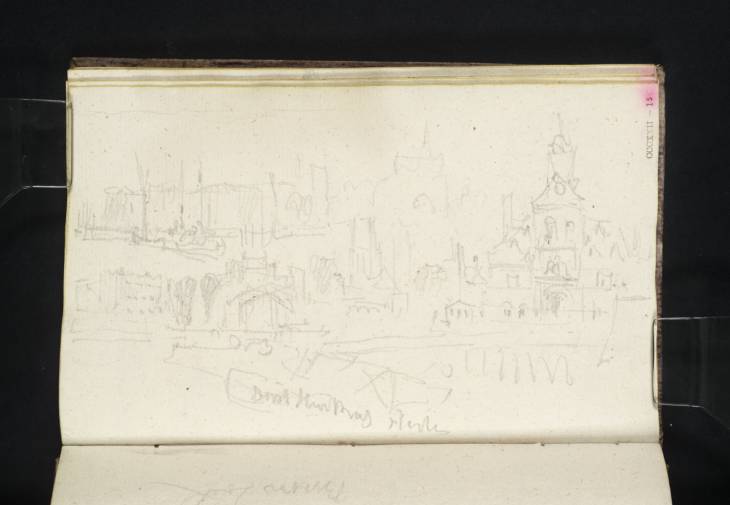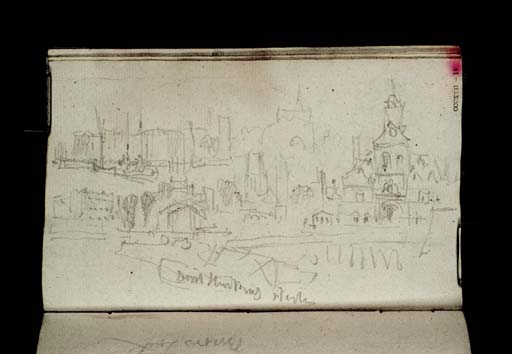Joseph Mallord William Turner The Oude Haven, Rotterdam, with the Ooster Oude Hoofdpoort, and St Lawrence's Church Beyond 1833
Image 1 of 2
Joseph Mallord William Turner,
The Oude Haven, Rotterdam, with the Ooster Oude Hoofdpoort, and St Lawrence's Church Beyond
1833
Joseph Mallord William Turner 1775–1851
Folio 14 Recto:
The Oude Haven, Rotterdam, with the Ooster Oude Hoofdpoort, and St Lawrence’s Church Beyond 1833
D32568
Turner Bequest CCCXXII 15
Turner Bequest CCCXXII 15
Pencil on white laid paper, 105 x 170 mm
Partial watermark: base of unicorn motif
Inscribed by Turner in pencil ‘[?D... H... B... stork]’ bottom centre
Inscribed by John Ruskin in red ink ‘15’ top right, ascending vertically (smudged and faint)
Stamped in black ‘CCCXXII – 15’ top right, ascending vertically
Partial watermark: base of unicorn motif
Inscribed by Turner in pencil ‘[?D... H... B... stork]’ bottom centre
Inscribed by John Ruskin in red ink ‘15’ top right, ascending vertically (smudged and faint)
Stamped in black ‘CCCXXII – 15’ top right, ascending vertically
Accepted by the nation as part of the Turner Bequest 1856
References
1909
A.J. Finberg, A Complete Inventory of the Drawings of the Turner Bequest, London 1909, vol.II, p.1036, CCCXXII 15, as ‘View of town’.
1978
Agnes von der Borch, Studien zu Joseph Mallord William Turners Rheinreisen (1817–1844) (Ph.D thesis, Rheinischen Friedrich-Wilhelms-Universität, Bonn 1972), Bonn 1978, p.93, as among unspecified Rhine subjects (sic).
With the page turned horizontally, the swiftly rendered full-page composition shows the Oude Haven in Rotterdam. On the right is the Ooster Oude Hoofdpoort gateway, indicating that the harbour is seen from the east. The outline of the tower of St Lawrence’s Church (the Sint-Laurenskerk) rises in the centre beyond, to the north-west. Above is what seems to be a reprise from a similar angle, with moored boats on the left. The elaborate gateway is the main subject on folio 45 recto (D32628; CCCXXII 46).
The loose shapes in the foreground perhaps relate to barges and their cargoes or quayside gear, and Turner’s notes are elusive. One possibility is that the last word is ‘stork’ or ‘storks’, which could indicate birds like those ‘kept to clean [the] fishmarket’ in Amsterdam, as Fred Bachrach noted in relation to a clearer annotation to a view of that city in the 1825 Holland sketchbook (Tate D19034; Turner Bequest CCXIV 98a).1 ‘Doves’ were certainly noted in Rotterdam in the present book, on folios 43 recto and 47 recto (D32624, D32632; CCCXXII 44, 48).
Although the layout of the city’s central streets and harbours has been broadly preserved, very few buildings (notably St Lawrence’s) survived destruction in May 1940, and identification is based largely on earlier visual documentation. As set out in the Introduction, this sketchbook covers Turner’s north-westwards homeward route from Augsburg (see under folio 1 verso; D32543; CCCXXII 2a) to Rotterdam. Travelling back down the familiar river, he worked in somewhat randomly from both ends, interspersing identifiable subjects with less distinctive renderings of towns, castles and the landscape. The Rotterdam subjects run continuously here and there for a few previously blank leaves around the middle, others were inserted between earlier subjects, with some sharing pages with existing drawings. Turner thriftily used up virtually all the available space at this last stop on his lengthy tour, presumably with some time on his hands while awaiting his ship home.
Consequently, the sketches are the most numerous to be devoted to a single location; see also folios 17 verso, 23 recto, 24 verso, 27 verso, 28 recto–29 recto, 30 verso–33 recto, 35 recto and verso, 38 recto and verso, 40 recto–45 recto, 46 verso–47 recto, and 56 verso–57 recto (D32575, D32586, D32589, D32593, D32595–D32597, D32600–D32605, D32608–D32609, D32614–D32615, D32618–D32628, D32631–D32632, D32650–D32651; CCCXXII 18a, 24, 25a, 28, 29–30, 31a, 34, 36, 36a, 39, 39a, 41–46, 47a, 48, 57a, 58). In addition, folio 62 verso (D32662; CCCXXII 63a) includes a written note of a prominent building which was not actually depicted, while the memoranda on the front cover’s label (D41140) includes the city’s name, apparently in relation to the voyage back to London.
Turner had already explored the city thoroughly, in the 1817 Dort sketchbook (Tate D13012–D13013, D13019–D13023, D13026, D13028–D13031, D13139–D13141; Turner Bequest CLXII 9, 9a, 13–15, 16a, 17a–19, 75, 76, 76a), the 1825 Holland sketchbook (D18907–D18916, D18921–D18922, D18926, D18928–D18932, D18950–D18951, D18954–D18957, D18961–D18964, D18971–D18974, D18976, D18978, D18981–D18997; CCXIV 34a–39, 41a–42a, 44, 45a–47a, 56a–57, 58a–60, 62–63a, 67–68a, 69a, 70a, 72–80) and the Holland, Meuse and Cologne book of that year (D19483–D19485, D19487–D19488; CCXV 52a–53a, 54a–55).
There is possibly a view in the 1835 Prague, Nuremberg, Frankfurt and Rhine sketchbook (Tate D30728; Turner Bequest CCCIV 51a, and many more in the same year’s Rotterdam book (D32444, D32446, D32448, D32450–D32451, D32453, D32455, D32457–D32458, D32460–D32462, D32464, D32466, D32468–D32470, D32473, D32480, D32483–D32498, D32503–D32506; CCCXXI 1, 2, 3, 4, 4a, 5a, 6a, 7a, 8, 9–10, 11, 12, 13, 13a, 14, 15a, 19, 20a–28a, 32–33a). 1840’s Rotterdam to Venice sketchbook contains just two more: D32264, D32265 (CCCXX 1v, 2).
All of this activity had resulted in a single painting, the Rotterdam Ferry Boat (National Gallery of Art, Washington DC),2 exhibited in 1833, shortly before the present tour. Its offshore view was informed by various 1817 Dort sketches. An engraving of about 1836, Fish Market, Rotterdam (Tate impressions: T05149, T05150), is apparently from an untraced watercolour3 based on Tate D32453 (Turner Bequest CCCXXI 5a) in 1835’s Rotterdam sketchbook.
Matthew Imms and Quirine van der Meer Mohr
November 2019
How to cite
Matthew Imms and Quirine van der Meer Mohr, ‘The Oude Haven, Rotterdam, with the Ooster Oude Hoofdpoort, and St Lawrence’s Church Beyond 1833 by Joseph Mallord William Turner’, catalogue entry, November 2019, in David Blayney Brown (ed.), J.M.W. Turner: Sketchbooks, Drawings and Watercolours, Tate Research Publication, March 2023, https://www


